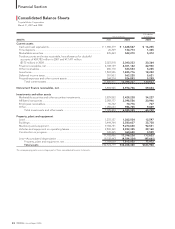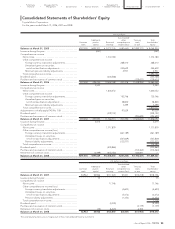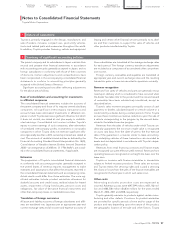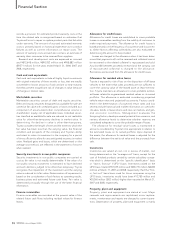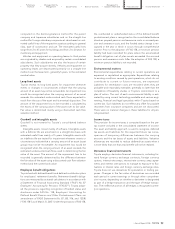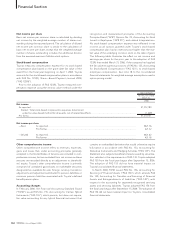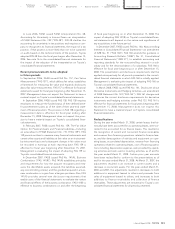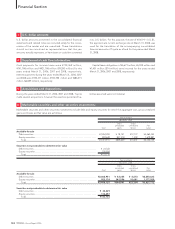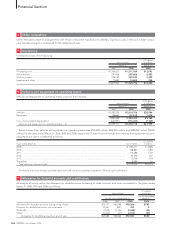Toyota 2008 Annual Report Download - page 103
Download and view the complete annual report
Please find page 103 of the 2008 Toyota annual report below. You can navigate through the pages in the report by either clicking on the pages listed below, or by using the keyword search tool below to find specific information within the annual report.
101
•Annual Report 2008 • TOYOTA
Performance Messages from the Management &
•Overview •Management •Special Feature •Business Overview •Corporate Information •Financial Section •Investor Information •
In June 2006, FASB issued FASB Interpretation No. 48,
Accounting for Uncertainty in Income Taxes—an interpretation
of FASB Statement No. 109
(“FIN 48”). FIN 48 clarifies the
accounting for uncertainty in tax positions and requires a com-
pany to recognize in its financial statements, the impact of a tax
position, if that position is more likely than not to be sustained
on audit, based on the technical merits of the position. Toyota
adopted FIN 48 from the fiscal year begun after December 15,
2006. See note 16 to the consolidated financial statements for
the impact of the adoption of the interpretation on Toyota’s
consolidated financial statements.
Recent pronouncements to be adopted
in future periods
In September 2006, FASB issued FAS No. 157,
Fair Value
Measurements
(“FAS 157”), which defines fair value, establishes
a framework for measuring fair value and expands disclosures
about fair value measurements. FAS 157 is effective for financial
statements issued for fiscal year beginning after November 15,
2007. Management does not expect this Statement to have a
material impact on Toyota’s consolidated financial statements.
In September 2006, FASB issued FAS 158. FAS 158 requires
employers to measure the funded status of their defined bene-
fit postretirement plans as of the date of their year-end state-
ment of financial position. This provision in FAS 158 regarding a
measurement date is effective for fiscal year ending after
December 15, 2008. Management does not expect this provi-
sion to have a material impact on Toyota’s consolidated finan-
cial statements.
In February 2007, FASB issued FAS No. 159,
The Fair Value
Option for Financial Assets and Financial Liabilities—Including
an amendment of FASB Statement No. 115
(“FAS 159”). FAS
159 permits entities to measure many financial instruments and
certain other assets and liabilities at fair value on an instrument-
by-instrument basis and subsequent change in fair value must
be recorded in earnings at each reporting date. FAS 159 is
effective for fiscal year beginning after November 15, 2007.
Management is evaluating the impact of adopting FAS 159 on
Toyota’s consolidated financial statements.
In December 2007, FASB issued FAS No. 141(R),
Business
Combinations
(“FAS 141(R)”). FAS 141(R) establishes principles
and requirements for how the acquirer recognizes and mea-
sures the identifiable assets acquired, the liabilities assumed,
any noncontrolling interest, and the goodwill acquired in a busi-
ness combination or a gain from a bargain purchase. Also, FAS
141(R) provides several new disclosure requirements that
enable users of the financial statements to evaluate the nature
and financial effects of the business combination. FAS 141(R) is
effective to business combinations on and after the beginning
of fiscal year beginning on or after December 15, 2008. The
impact of adopting FAS 141(R) on Toyota’s consolidated finan-
cial statements will depend on the nature and significance of
any acquisitions in the future period.
In December 2007, FASB issued FAS No. 160,
Noncontrolling
Interests in Consolidated Financial Statements—an amendment
of ARB No. 51
(“FAS 160”). FAS 160 amends the guidance in
Accounting Research Bulletin (“ARB”) No. 51,
Consolidated
Financial Statements
(“ARB 51”), to establish accounting and
reporting standards for the noncontrolling interest in a sub-
sidiary and for the deconsolidation of a subsidiary. FAS 160 is
effective for fiscal year beginning on or after December 15,
2008. The presentation and disclosure requirements shall be
applied retrospectively for all periods presented in the consoli-
dated financial statements in which FAS 160 is initially applied.
Management is evaluating the impact of adopting FAS 160 on
Toyota’s consolidated financial statements.
In March 2008, FASB issued FAS No. 161,
Disclosures about
Derivative Instruments and Hedging Activities—an amendment
of FASB Statement No. 133
(“FAS 161”). FAS 161 changes and
enhances the current disclosure requirements for derivative
instruments and hedging activities under FAS 133. FAS 161 is
effective for financial statements for fiscal years beginning after
November 15, 2008. Management does not expect this
Statement to have a material impact on Toyota’s consolidated
financial statements.
Reclassifications
During the year ended March 31, 2008, certain leases that his-
torically have been accounted for as operating leases, were cor-
rected to be accounted for as finance leases. This resulted in
the recognition of current and noncurrent finance receivables
and revenue from financing operations related to finance leas-
es, and the derecognition of vehicles and equipment on oper-
ating leases, accumulated depreciation, revenue from financing
operations related to operating leases, cost of financing opera-
tions including depreciation expense, cash provided by operat-
ing activities and cash used in investing activities, as of and for
the year ended March 31, 2008. Certain prior year amounts
have been reclassified to conform to the presentations as of
and for the year ended March 31, 2008. At March 31, 2007, the
adjustments resulted in an increase in current assets and a
decrease in noncurrent assets. For the years ended March 31,
2006 and 2007, the adjustments resulted in decreases to both
additions to equipment leased to others and proceeds from
sales of equipment leased to others, and increases to both
additions to finance receivables and collection of finance
receivables. These adjustments are immaterial to Toyota’s con-
solidated financial statements for all periods presented.



